Import from Confluence
The import from Confluence lets you migrate one or more spaces including articles, comments, attachments, and users from a cloud or self-hosted Confluence service to YouTrack's Knowledge Base.
A setup wizard navigates you through the import configuration process. It prompts you to enter the connection settings and lets you map projects in YouTrack to spaces in Confluence. If your Confluence has a custom set of fields for articles, you can edit the import script in YouTrack directly.
Prerequisites
Before you import spaces from Confluence to YouTrack, check the following requirements:
Your Confluence version is 5.5.6 or later. The ability to import articles from earlier versions of Confluence has not been verified.
If you're importing content from a self-managed Confluence Server installation, the Confluence installation must be accessible over the internet. Specifically, you need to make sure that your network doesn't block connections between your Confluence installation and YouTrack.
Your user account in Confluence has administrative permissions.
You have direct access to log in to the source application using a password or token.
YouTrack's import engine doesn't support authentication through external authentication modules.
Import Details
If the Confluence database contains references to entities that do not exist in YouTrack yet, they are created. The YouTrack user account you use to run the import should have enough permissions to create all imported entities. We recommend using an account with a System Admin role or the Low-level Admin Write permission to run the import.
Imported Entities
Here is the list of entities that are imported from Confluence and their mapping to YouTrack entities:
Entity in Confluence | Entity in YouTrack |
|---|---|
Space | Project |
Article | Article |
Comment | Comment |
User | User |
Group | Group |
Importing User Data
This integration also imports user accounts that are stored in the Confluence instance. The same values for users who created, updated, added comments to articles in Confluence are set to the corresponding user accounts in YouTrack.
Confluence Cloud limits the amount of user data that is accessible through a programmatic interface. In order to successfully map user activity in Confluence to imported articles in YouTrack, you need to upload a copy of the dataset for Confluence users to YouTrack before you start importing Confluence space data.
During setup, you are asked to upload a CSV file that contains information about the user accounts that are currently stored in your Confluence database. If you don't have access to download this information, you will not be able to import data from your Confluence instance.
Self-hosted Confluence Server installations are not subject to this limitation. This means that you don't have to manually export and upload user data before you can import your articles into YouTrack.
To export user data for your Confluence instance:
Navigate to the Directory section in Atlassian Administration and open the Users page.
From the More menu in the upper-right corner of the header, click the Export users button.
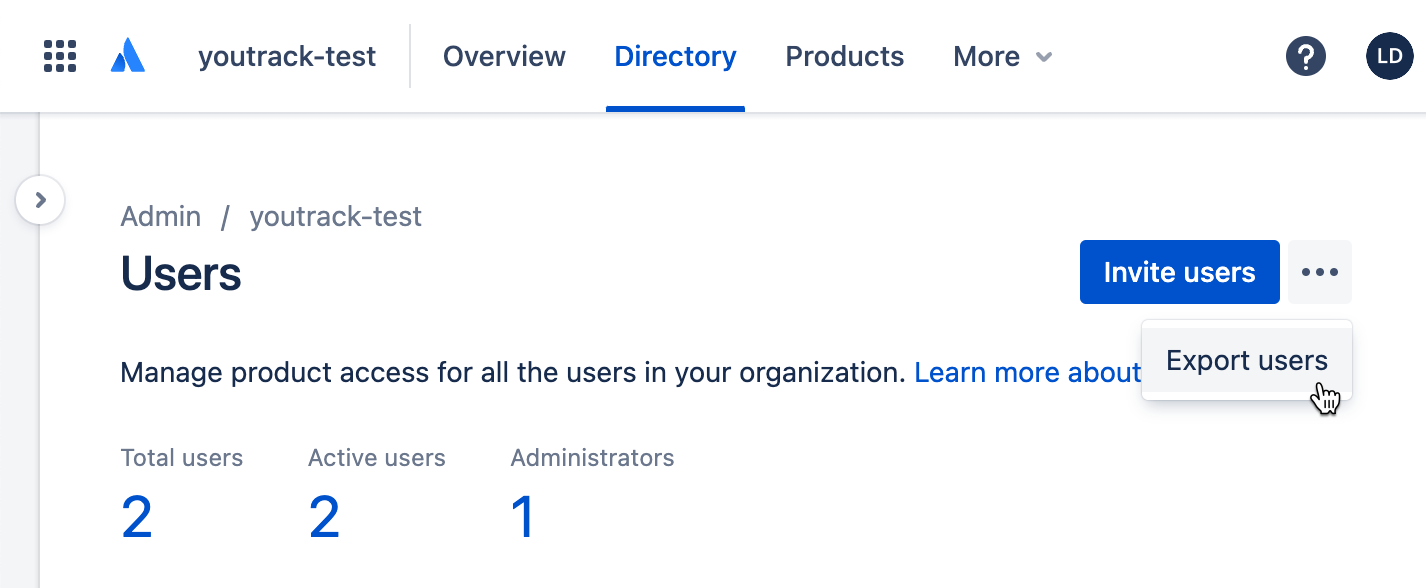
The Export users to CSV page opens.
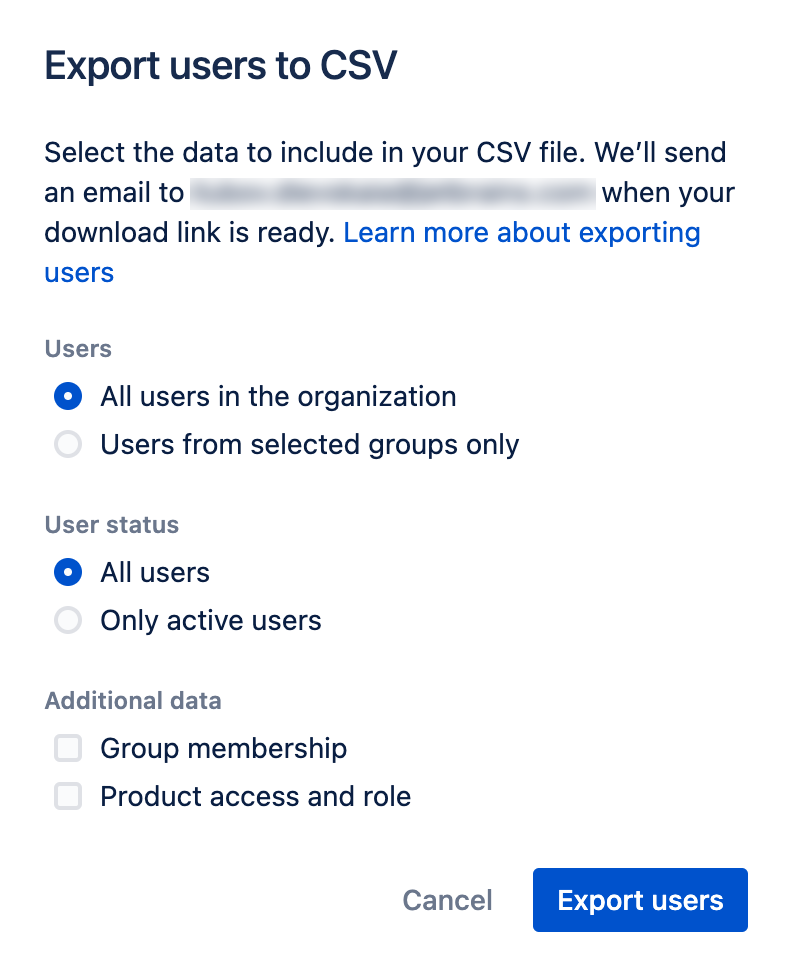
Use the following guidelines to configure the user selection for export:
Setting
Description
Users
Choose whether you want to export all users on the site or only from selected groups. Your selection should include all users who are associated with any issue-related events in the imported projects.
User Status
Choose whether you only want to export active users or all users. For best results, we suggest exporting all users.
Additional Data
Choose whether to export group membership and product access data. The data that is included in the user export file when these options are enabled are not required for importing issues into YouTrack.
Click the Export users button.
Confluence generates a CSV file that contains user data from your Confluence instance and sends it to your email.
Open your mailbox and download the CSV file with the user data.
Set up an Import from Confluence
Before you add a new import configuration, prepare the credentials that will grant access to your Confluence instance. You will need these credentials for authorization when setting up the import in YouTrack.
To configure an import from Confluence Cloud, you will need an API token. For details on creating an API token, see Create an API Token for Confluence Cloud.
Create an API Token for Confluence Cloud
To set up an import of articles from Confluence Cloud, first, you need to create an API token for your Atlassian account.
To create an API token for the Atlassian account:
Log in to the Atlassian account settings with an account that is granted administrative permissions.
Click the Create API token button and provide a label for the token.
Click Create.
The new API token is added to the list.

For more details on creating API keys for Atlassian products, refer to the Atlassian documentation.
Configure an Import from Confluence in YouTrack
The setup wizard guides you through the setup process.
To configure an import from Confluence:
From the Administration menu, select .
Click New import to open the setup dialog.
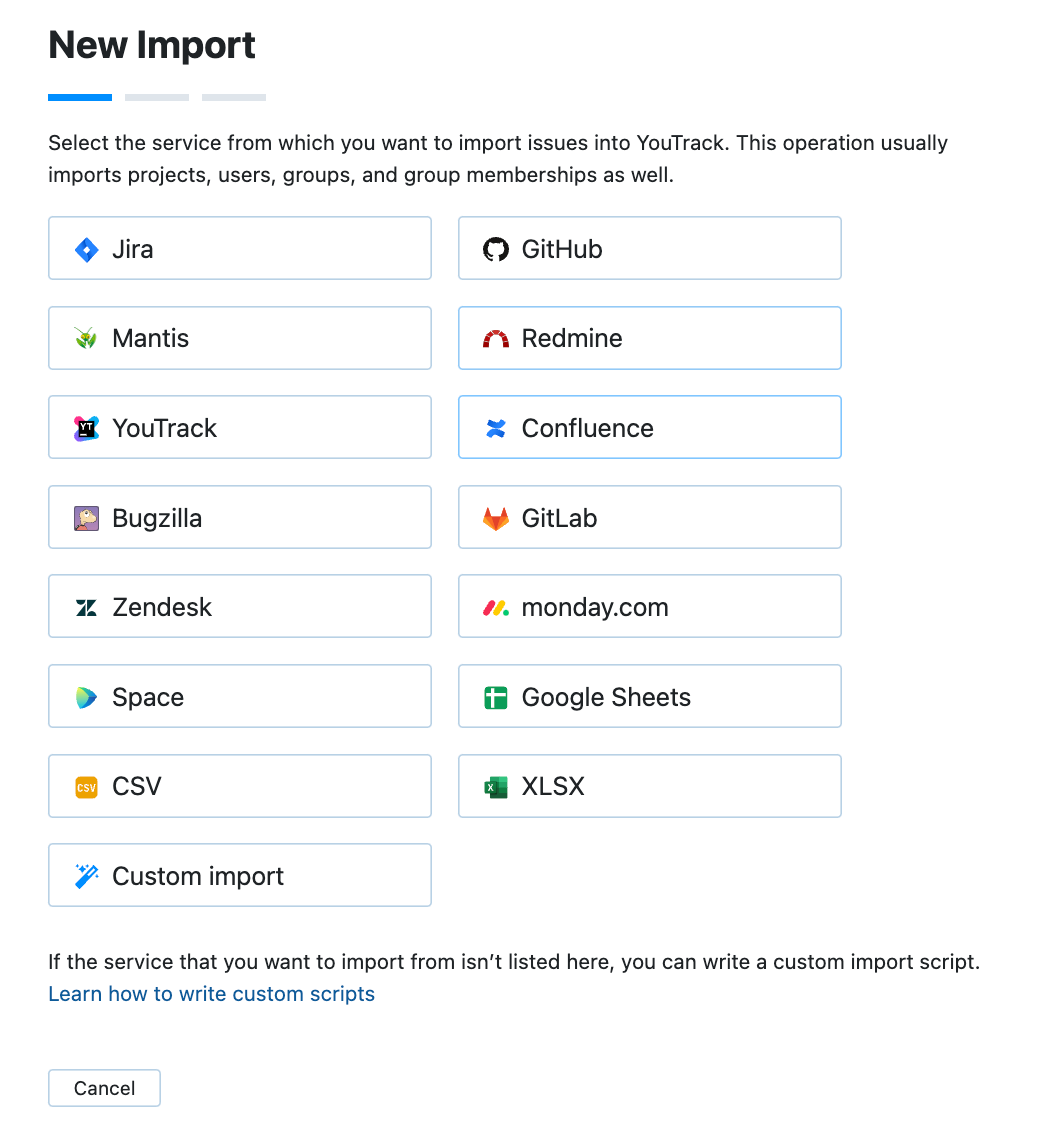
Select Confluence.
Settings for a New Import from Confluence are displayed.
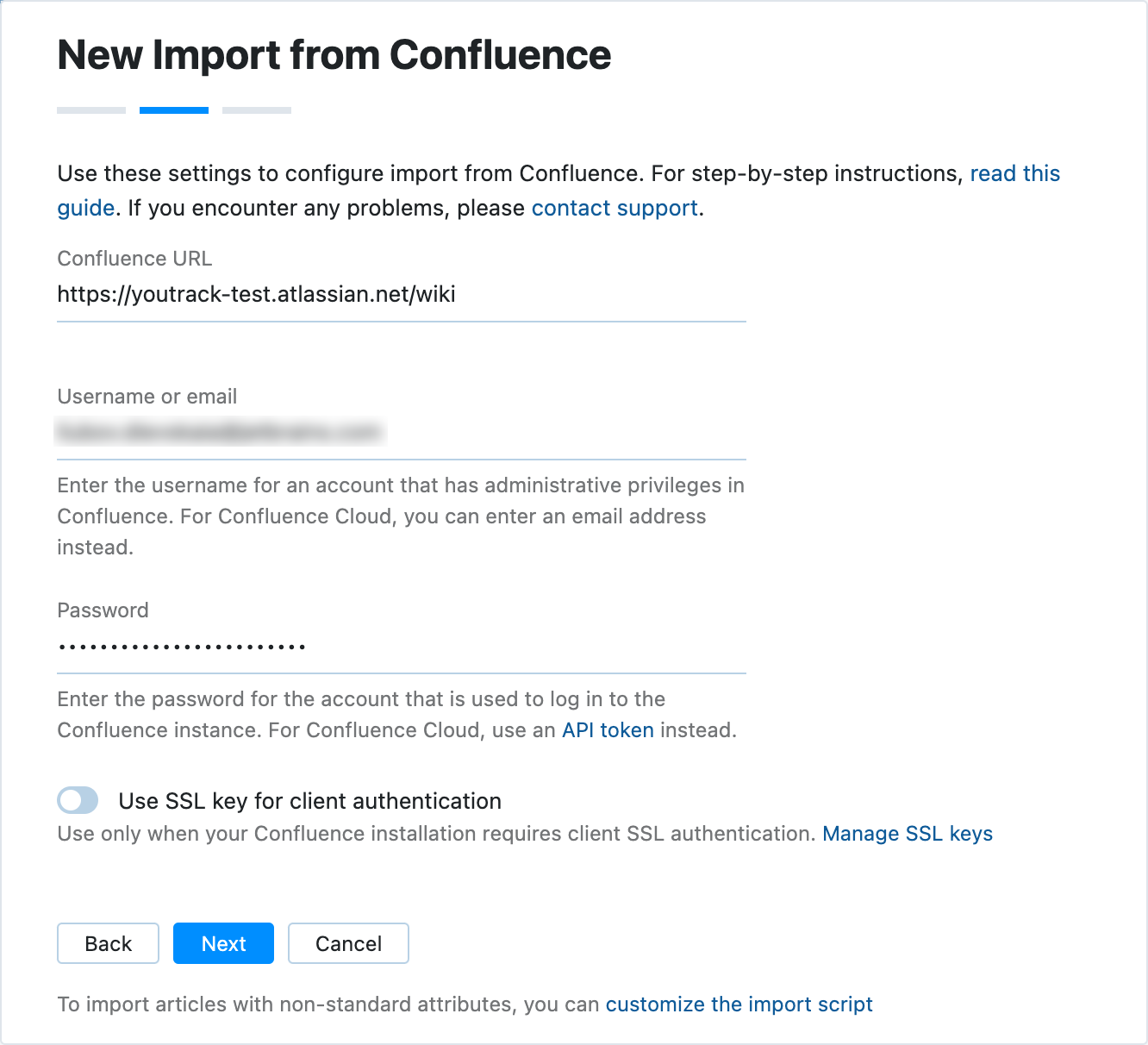
Enter values for the following settings:
Setting
Description
Confluence URL
Enter the base URL of the Confluence instance. For Confluence Cloud, make sure to include the
/wikipath in the URL.Username or email
Enter the username of the account that is used to log in to Confluence. This account must have access to the spaces that you need to import.
Password
Enter the password for the account that is used to log in to the Confluence instance.
For Confluence Cloud, create an API token for your Atlassian account and paste it into the input field.
If required by your Confluence instance, enable the Use SSL key for client authentication option.
Click the Next button.
The second set of import settings is displayed.
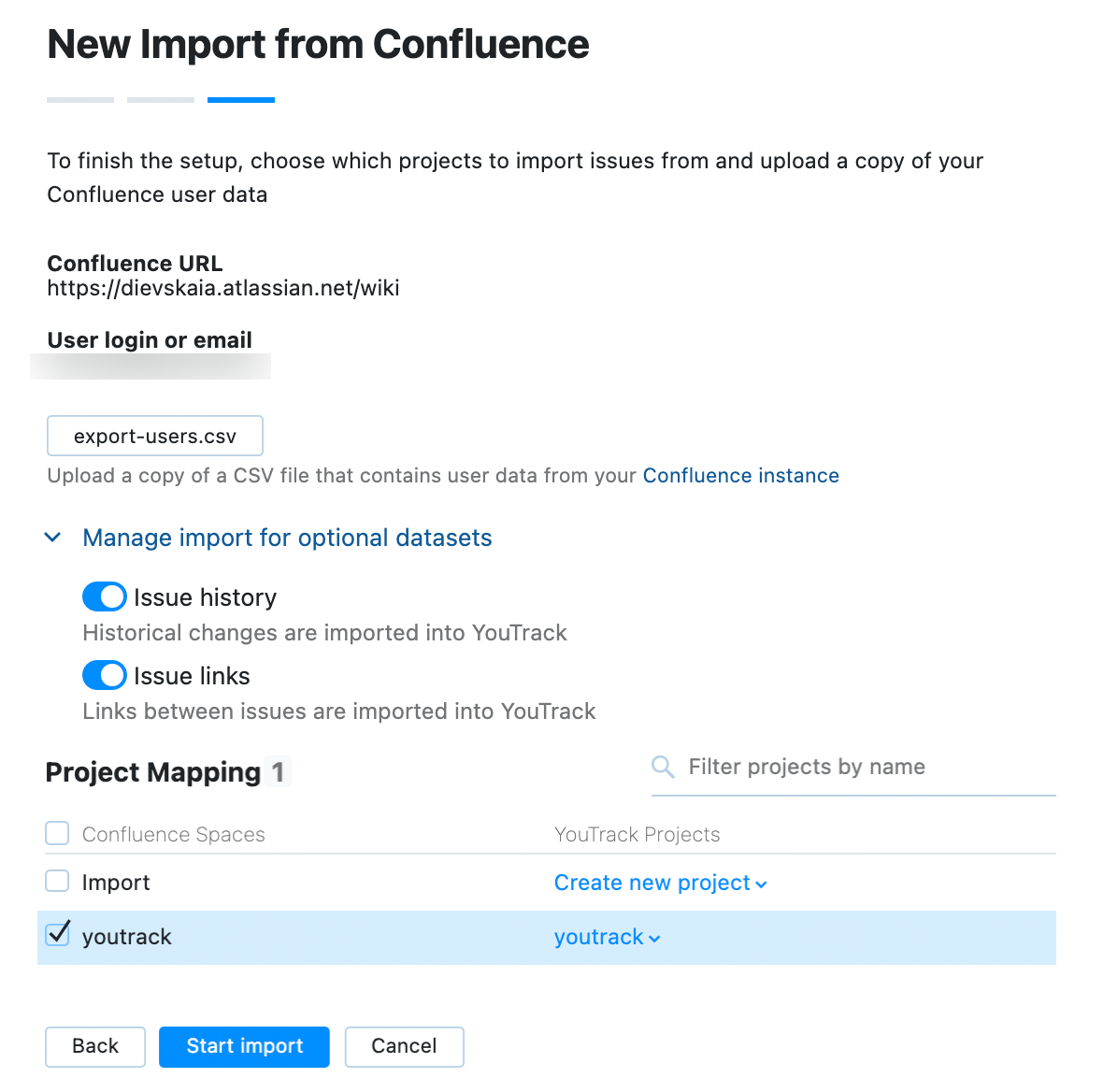
Expand the Manage import for optional datasets section. Here you can configure the import engine to ignore certain parts of the source database during import.
Setting
Description
Issue history
Disable this toggle to ignore historical changes of issues during import.
Issue links
Disable this toggle to ignore links between issues during import.
By default, these toggles are enabled. This means that YouTrack will pull historical changes and issue links from the import source if the import script supports it.
Select the Confluence spaces and target projects for import. For details, see Project Mapping.
Optionally, you can also upload a CSV file with the user data from the source Confluence service. For details, see Importing User Data.
Click the Start import button.
YouTrack will create new projects and import data to the existing ones according to the configured project mapping.
YouTrack will import articles, comments, and users to the target projects.
When you have set up an import project, it appears in the Imports list. To view configuration and import details, select an import configuration from the list.
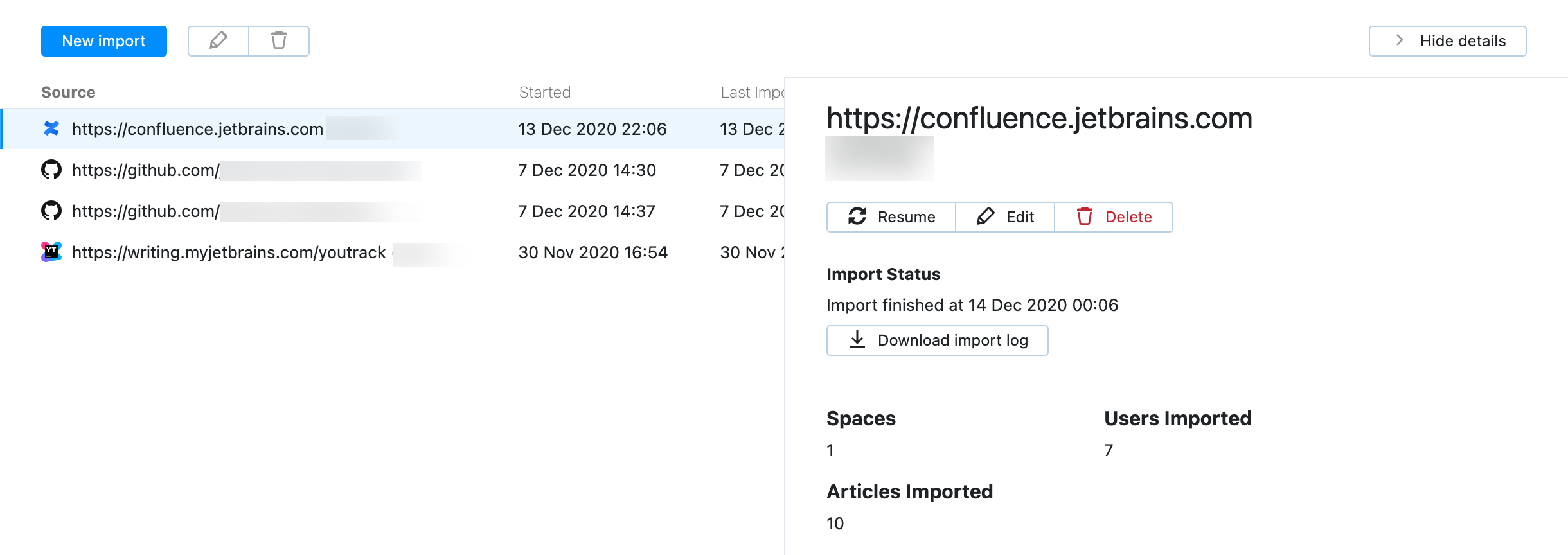
In the details sidebar, YouTrack shows import status and details on the data that was imported. Click the Resume button in the toolbar to explicitly start polling for changes and importing updates from the source Confluence instance.
You can also download the import log file to study and investigate when needed.
Project Mapping
On the final step of the import setup, you have an option to select those Confluence spaces that you want to import to YouTrack. You can also choose whether to create a new project for the import or import data into an existing project in YouTrack.

To configure project mapping:
Locate those Confluence spaces that you want to import.
Use the filter bar on the right to filter projects by name.
Select the spaces that you want to import. Select the option at the top of the list to import all available Confluence spaces.
Select a target YouTrack project for each Confluence space.
When loading the list of Confluence spaces for mapping, YouTrack checks for existing YouTrack projects with corresponding names. If it finds a YouTrack project with the same name as the Confluence space, YouTrack suggests it as the target project.
If there is no existing YouTrack project with the corresponding name, YouTrack suggests creating a new one.
If you want to change a target project, select another option from the corresponding dropdown on the list.
Click Start import to finalize import setup and start the import.
Import starts.
Import Options
After the initial import, the following controls are available in the sidebar:
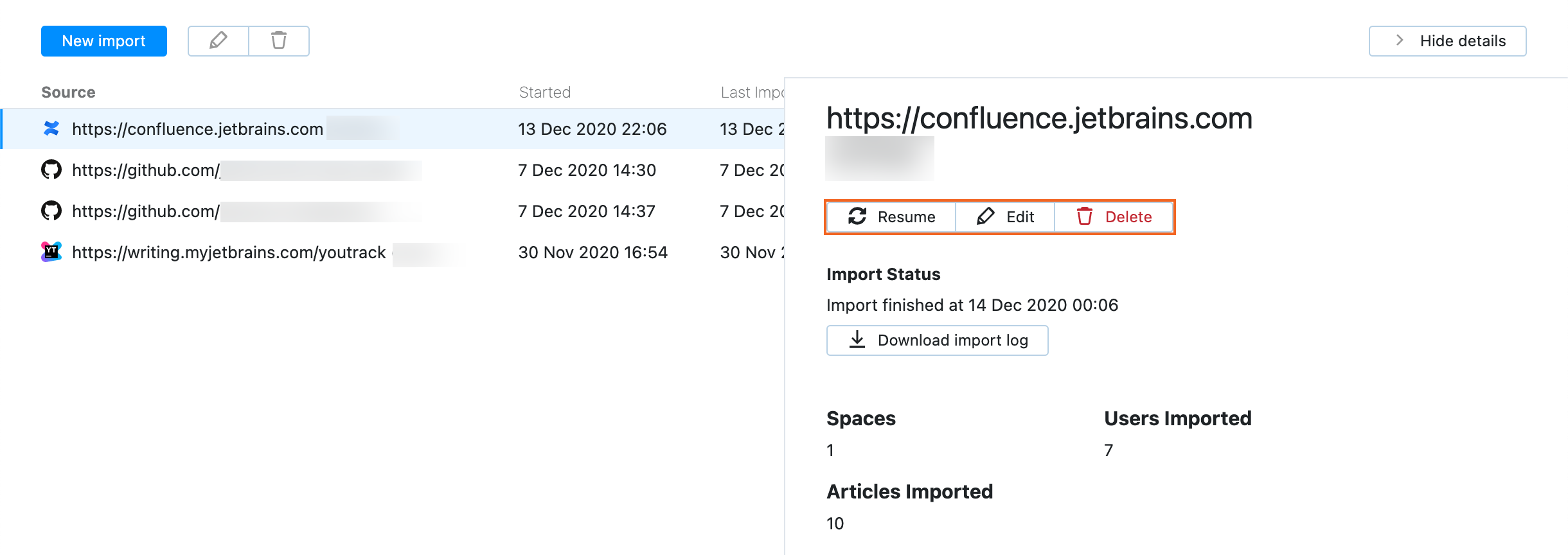
Control | Description |
|---|---|
Resume | Immediately imports any changes made in the selected Confluence spaces after the previous import. |
Edit | Opens the integration settings page in edit mode. Use this option to connect to a different Confluence instance, update the login credentials, or update project mapping. |
Delete | Deletes the current import settings. Projects, articles, comments, users, and groups that were imported from the connected Confluence instance are not affected. If you delete the import settings and connect to the same Confluence instance, the articles are re-imported into existing projects with new IDs. |